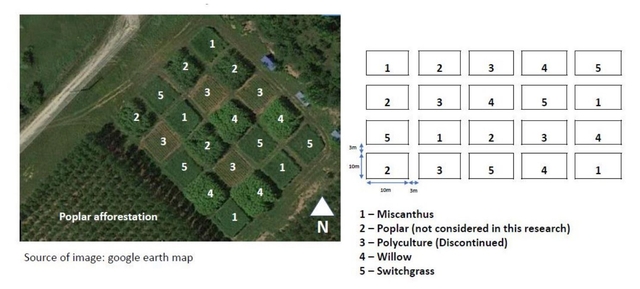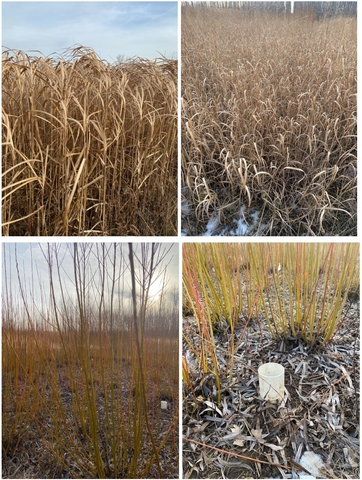Establishing perennial bioenergy crops on marginal lands that do not compete with food crops for land occupation is viewed as an innovative approach to meeting our current and future energy demands while ensuring food security (Norgrove 2010). This is because perennial grasses and short-rotation woody crops such as switchgrass (Panicum virgatum), miscanthus (Miscanthus giganteus), and willow (Salix miyabeana) have high energy potentials and capable of growing on marginal lands with minimal or no external nutrient requirements, alleviating the need to divert agricultural lands and food crops into energy production (Chimento et al. 2016; Searchinger and Heimlich 2015). In addition to rapidly accumulating biomass on marginally productive agricultural lands for energy use, their long-term land occupation helps to regenerate these marginal lands on which they grow (Chimento et al. 2016). As a result, growing perennial bioenergy crops on marginal lands is promoted as a land management strategy, which provides a ‘sustainable’ energy alternative to fossil fuels with climate mitigation benefits (Agostini et al. 2015).
In spite of this, uncertainties still remain concerning the greenhouse gas (GHG) emissions associated with perennial bioenergy crops grown on marginal lands and the impact they could have on the global climate (Daioglou et al. 2017). Moreover, winter and freeze-thaw cycles (FTC) often result in N2O and CO2 pulses, accounting for a significant proportion of the annual GHG budget (Matzner and Borken 2008). Therefore, in the cold northern temperate regions where FTC are a common occurrence in the winter, GHG emissions during the winter could be substantial. Even more so will be the predicted increased climate variability from climate change that will result in more frequent FTC (Wagner-Riddle et al. 2017). This makes it imperative to understand the effects establishing perennial bioenergy crops on marginal lands will have on winter GHG emissions during FTC as this information is lacking. It is for this reason that a long-term study is ongoing to evaluate the temporal GHG emissions in perennial bioenergy crops on marginal land in southern Canada.
The study site, which currently receives no fertilization was established in 2009 with five treatments of i) willow (Salix miyabeana clone SX67), ii) poplar (Populus spp. clone 2293‐19), iii) switchgrass (Panicum virgatum var. Cave-in-Rock), iv) Miscanthus giganteus (Nagara), and v) herbaceous polyculture in a 25:25:25:25 mix composed of [indiangrass (Sorghastrum nutans); big bluestem (Andropogon gerardi); little bluestem (Schizachyrium scoparium); and switchgrass (Panicum virtatum)]. These treatments are assigned in a randomized complete block design in 4 replications. Each of the replicates consists of a 10 m x 10 m plot separated from each other by 3 m boarders (Figure 1).

The current study only considers the willow, switchgrass, and miscanthus as the polyculture field no longer exists and the poplar is not growing well after coppicing (based on field observation). The soil at the study site has previously been described by Marshal et al. (2016) as a Luvisol with a fine sandy-loam texture. This site falls under class 4 in the Canadian Land Inventory (CLI) classification system, which is limited by slope and stoniness (30 cm depth to bedrock). Soils classified as class 4 or worse are considered marginal agricultural lands unsuitable for growing food crops (Marshal et al. 2016). Prior to establishing the perennial biomass crops, the site was under corn (Zea mays), bean (Glycine max) and wheat (Triticum vulgare) rotation for about 25 years until 2008, and as the crop yields were very low, the field was converted to biomass research field in 2009 (Marshal et al., 2016). The switchgrass and miscanthus are harvested annually while the willow is harvested every third year.
Two PVC chambers (25 cm height, 10 cm radius), per treatment replicate to a 10 cm depth were installed in the miscanthus, switchgrass, and willow plots (Figure 2) in September 2019 and bi-weekly sampling and measurements of CO2 and N2O (Figure 3) have been ongoing in these plots since October 2019. Methane (CH4) measurement is not considered for this study, as upland soils are considered as sinks rather than as sources of CH4 emissions (Walkiewicz et al. 2012).

 Figure 3 October 2019 greenhouse gas sampling in switchgrass at the University of Guelph Agroforestry Research Station, southern Ontario, Canada.
Figure 3 October 2019 greenhouse gas sampling in switchgrass at the University of Guelph Agroforestry Research Station, southern Ontario, Canada.
This article presents the preliminary findings for our first winter sampling (October – December) for 2019. It must be indicated that, results for the January and February months could not be obtained due to the presence of heavy snow cover making it impossible for GHG chambers to be retrieved for gas sampling during those two months.
Table 1 Mean winter CO2-C and N2O-N emissions from the three perennial bioenergy crops on marginal land in southern Ontario, Canada. Standard errors are given in parentheses.
|
|
Miscanthus |
Switchgrass |
Willow |
|
CO2 emissions (mg CO2-C m-2 h-1) |
77.56 (12.28)A |
83.25 (15.46)A |
65.90 (10.17)A |
|
N2O emissions (µg N2O-N m-2 h-1) |
-6.21 (14.37)A |
3.02 (4.81)A |
-2.57 (4.65)A |
A Within rows means followed by the same uppercase letter are not significantly different (p > 0.05)
Preliminary data for the winter emissions (Table 1) revealed numerically higher CO2-C and N2O-N emissions in the switchgrass than the willow and miscanthus; these are however, not statistically different. The CO2-C emissions recorded here indicates a possible soil microbial activity in winter conditions resulting in the CO2-C emissions. It is also curious to observe that, whereas the miscanthus and willow served as sinks for N2O-N, that of switchgrass served as a source. Further studies are ongoing to understand the processes governing the mechanisms responsible for these and their implications on the total atmospheric GHG budget.
References
Agostini F, Gregory AS, Richter GM (2015) Carbon sequestration by perennial energy crops: is the jury still out? Bioenergy Research 8: 1057 – 1080
Chimento C, Almagro M, Amaducci S (2016) Carbon sequestration potential in perennial bioenergy crops: the importance of organic matter inputs and its physical protection. Global Change Biology Bioenergy 8: 111–121. doi: 10.1111/gcbb.12232
Daioglou V, Doelman JC, Stehfest E, Müller C, Wicke B, Faaij A, van Vuuren DP (2017) Greenhouse gas emission curves for advanced biofuel supply chains. Nature Climate Change 7: 920 – 924
Marsal F, Thevathasan NV, Guillot S, Mann J, Gordon AM, Thimmanagari M, Deen W, Silim S, Soolanayakanahally R, Sidders D (2016) Biomass yield assessment of five potential energy crops grown in southern Ontario, Canada. Agroforestry Systems 90: 773 – 783
Matzner E, Borken W (2008). Do freeze‐thaw events enhance C and N losses from soils of different ecosystems? A review. European Journal of Soil Science 59: 274 – 284
Norgrove L (2010) Impacts of biofuel production on food security. IUFoST Scientific Information Bulletin SIB. https://www.researchgate.net/publication/232071898_impacts_of_biofuel_production_on_food_security. Accessed 09 December 2019
Searchinger T, Heimlich R (2015) Avoiding bioenergy competition for food crops and land. Creating a Sustainable Food Future 1-44.
Wagner-Riddle C, Congreves KA, Abalos D, Berg AA, Brown SE, Ambadan JT, Gao X, Tenuta M (2017) Globally important nitrous oxide emissions from croplands induced by freeze–thaw cycles. Nature Geoscience 10: 279 – 283
Walkiewicz A, Bulak P, Brzezińska M, Włodarczyk T, Polakowski C (2012) Kinetics of methane oxidation in selected mineral soils. International Agrophysics 26: 401 – 406


